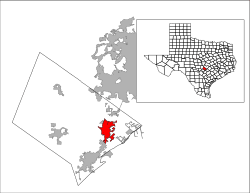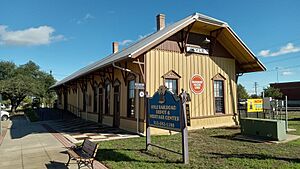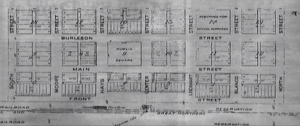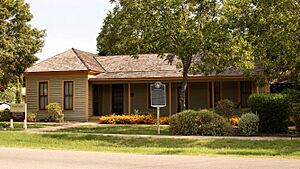Kyle, Texas facts for kids
Quick facts for kids
Kyle, Texas
|
|
|---|---|

Kyle City Hall
|
|
| Nickname(s):
Pie Capital of Texas
|
|

Location of Kyle, Texas
|
|
| Country | United States |
| State | Texas |
| County | Hays |
| Incorporated | 1928 |
| Named for | Fergus Kyle |
| Government | |
| • Type | Council–manager government |
| Area | |
| • Total | 31.27 sq mi (80.99 km2) |
| • Land | 31.07 sq mi (80.48 km2) |
| • Water | 0.20 sq mi (0.51 km2) |
| Elevation | 728 ft (222 m) |
| Population
(2020)
|
|
| • Total | 45,697 |
| • Density | 1,461.37/sq mi (564.23/km2) |
| Demonym(s) | Kyleite |
| Time zone | UTC−6 (Central (CST)) |
| • Summer (DST) | UTC−5 (CDT) |
| ZIP Code |
78640
|
| Area code(s) | 512 & 737 |
| FIPS code | 48-39952 |
| GNIS feature ID | 2411564 |
Kyle is a growing city in Hays County, Texas, United States. It's known as the "Pie Capital of Texas." The city's population has grown a lot, from about 28,000 people in 2010 to over 45,000 in 2020. This makes Kyle one of the fastest-growing cities in Texas! It's also part of the larger Greater Austin area.
Contents
Exploring Kyle's Location
Kyle is located in the eastern part of Hays County. To the south, it shares a border with San Marcos. To the northwest, it's next to Mountain City. Kyle is about 21 mi (34 km) southwest of downtown Austin. It's also about 58 mi (93 km) northeast of San Antonio. You can easily reach Kyle using Interstate 35.
Land and Water Around Kyle
The city covers an area of about 19.3 square miles (50.0 km2). Most of this area is land. A small part, about 0.2 sq mi (0.5 km2), is covered by water. The Blanco River flows through the western side of Kyle. The central and eastern parts of the city drain into Plum Creek. Both of these waterways eventually flow into the San Marcos River.
Learning in Kyle
Kyle has a strong focus on education for its young people. The oldest school building still in use was built in 1939. It was once Kyle High School and is now Kyle Elementary School.
High Schools in the Area
Older students in Kyle attend one of three high schools. These are Jack C. Hays High School, Lehman High School, and Johnson High School. The school district is called Hays Consolidated Independent School District. It's named after John Coffee Hays, a famous Texas Ranger.
Higher Education Opportunities
For students looking to continue their education, Kyle is close to Texas State University. This university is located just seven miles (11 km) north in San Marcos. Kyle is also home to the Hays campus of the Austin Community College District. This campus opened in 2014. It also has a Public Safety Training Center.
Getting Around Kyle
Kyle is well-connected for travel. There are several airports nearby. Austin–Bergstrom International Airport is about 25 mi (40 km) northeast. San Marcos Regional Airport is 10 mi (16 km) to the south. San Antonio International Airport is about 53 mi (85 km) to the southwest.
Rail Connections
The MoPac rail line runs through downtown Kyle. However, there isn't a train stop in Kyle right now. The Amtrak Texas Eagle passenger train stops about 10 mi (16 km) south of Kyle in San Marcos.
Major Roads and Highways
Residents in Kyle can easily access several important roads. These include I-35, SH 45 toll road, FM 150, FM 1626, SH 21, and SH 123.
 I-35 - This highway goes north to Buda and Austin. It goes south to San Marcos, New Braunfels, and San Antonio.
I-35 - This highway goes north to Buda and Austin. It goes south to San Marcos, New Braunfels, and San Antonio. FM 150 - This road connects to Driftwood and Dripping Springs to the northwest. It also connects to Uhland to the southeast.
FM 150 - This road connects to Driftwood and Dripping Springs to the northwest. It also connects to Uhland to the southeast. FM 1626 - This road links to the outer parts of Buda, Hays, and Manchaca.
FM 1626 - This road links to the outer parts of Buda, Hays, and Manchaca.
The Vybe Trail System
In 2021, the Kyle city council approved a new citywide trail system. It's called The Vybe. This system will connect residents using a mix of dirt, crushed granite, and paved trails. It will also use existing roads and trails.
Kyle's Past: A Look at History
Kyle was founded because of railroad expansion. A railroad leader named Jay Gould saw a chance to make money. He wanted to connect Austin and San Marcos, which had many cotton fields and farms. The original plan was to build the railroad through Mountain City. However, it was cheaper to build a straight track through the private land of Fergus Kyle and his wife, Anne Moore.
How Kyle Began
The Kyle and Moore families agreed to sell their land for $1. They also knew the land would become more valuable. The rights to the track were then sold to the Texas Land Company. This company was in charge of planning the new town. They filed the town plans on September 7, 1880. The first land lots were sold at an auction on September 25. This auction took place under a special tree, now called the 'Auction Oak'. The railroad even offered free rides and food from Austin to attract people.
Early Days and Growth
The new town attracted people and businesses from nearby Mountain City and Blanco. Farmers and ranchers also moved there. The first business in Kyle was a saloon and meat market. By 1883, Kyle's population was over 500. It grew to over 700 by the first census. However, the population later dropped during the Great Depression and the Dust Bowl.
Kyle officially became a city in 1928. It had a mayor and five council members. In 1937, Mary Kyle Hartson, Fergus Kyle's daughter, was elected mayor. She was elected again in 1944. During her time, Kyle had an all-woman city council. This made Kyle the only Texas town with an all-woman government!
Famous Author Connection
From 1892 to 1901, the famous author Pulitzer Prize-winning author Katherine Anne Porter lived in Kyle as a child. Many of her well-known short stories, like "Noon Wine," are set in and around Kyle. Her former home is now a special place for writers. It also hosts readings by visiting authors.
Kyle's Population Growth
| Historical population | |||
|---|---|---|---|
| Census | Pop. | %± | |
| 1890 | 779 | — | |
| 1910 | 742 | — | |
| 1920 | 744 | 0.3% | |
| 1930 | 606 | −18.5% | |
| 1940 | 874 | 44.2% | |
| 1950 | 888 | 1.6% | |
| 1960 | 1,023 | 15.2% | |
| 1970 | 1,629 | 59.2% | |
| 1980 | 2,093 | 28.5% | |
| 1990 | 2,225 | 6.3% | |
| 2000 | 5,314 | 138.8% | |
| 2010 | 28,016 | 427.2% | |
| 2020 | 45,697 | 63.1% | |
| 2022 (est.) | 57,470 | 105.1% | |
| U.S. Decennial Census 1850–1900 1910 1920 1930 1940 1950 1960 1970 1980 1990 2000 2010 2020 |
|||
Kyle has grown a lot over the years. In 2020, there were 45,697 people living in the city. There were 14,701 households and 10,370 families. Many households, about 54.2%, had children under 18 living with them. The average household size was 3.15 people. The average family size was 3.51 people.
Age and Income in Kyle
About 33.7% of the people in Kyle are under 18 years old. The median age in the city is 30.2 years. This means half the population is younger than 30.2 and half is older. In 2012–2016, the average yearly income for a household was about $72,191. For a family, it was about $76,992.
Pie Capital of Texas: A Sweet Story
Kyle worked hard to become known as the "Pie Capital of Texas." This was part of a plan to make the city more famous. On June 8, 2021, Kyle officially received this special designation.
The Pie in the Sky Hot Air Balloon Festival
To celebrate its pie status, Kyle used to host the Pie in the Sky Hot Air Balloon Festival. This event happened every year on Labor Day weekend since 2017. The festival featured amazing hot air balloon "mass ascensions" in the mornings. Balloons would take off at sunrise and fly over Kyle. In the evenings, there were "glows" where tethered balloons lit up the night sky at Lake Kyle.
However, the Kyle City Council decided to stop the festival in 2024. This was due to budget reasons. Also, hot air balloon events can be unreliable because they depend a lot on good weather.
Famous People from Kyle
Many interesting people have connections to Kyle. Here are a few:
- Fitzhugh Andrews – A talented composer.
- Gary Clark Jr. – A well-known musician.
- Roberto Garza – A former American football player.
- Otto Hofmann – An expert organ builder.
- Cecil "Tex" Hughson – An all-star baseball pitcher for the Boston Red Sox.
- Edwin Jackson Kyle – A U.S. Ambassador to Guatemala. Kyle Field is named after him.
- Helen Michaelis – An expert on Quarter Horses. She was the first woman in the American Quarter Horse Hall of Fame.
- Katherine Anne Porter – A famous author whose childhood home was in Kyle.
See also
 In Spanish: Kyle (Texas) para niños
In Spanish: Kyle (Texas) para niños




